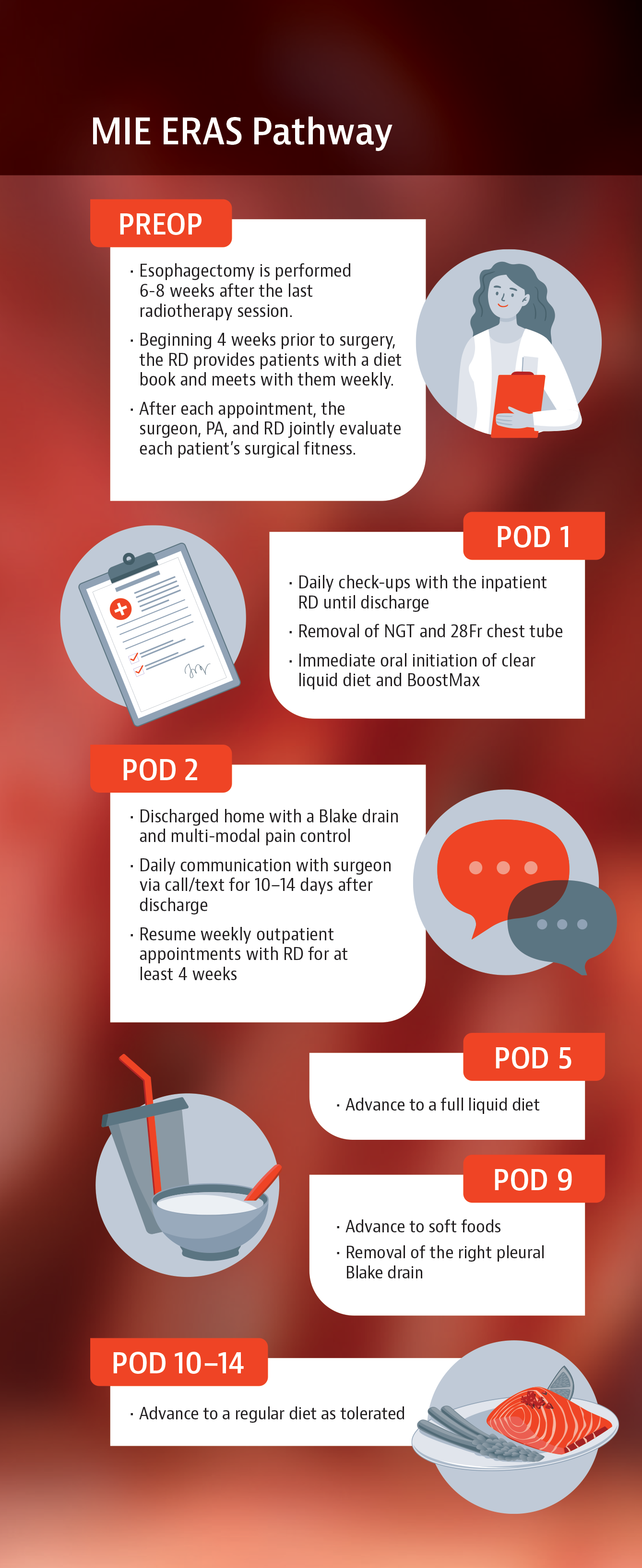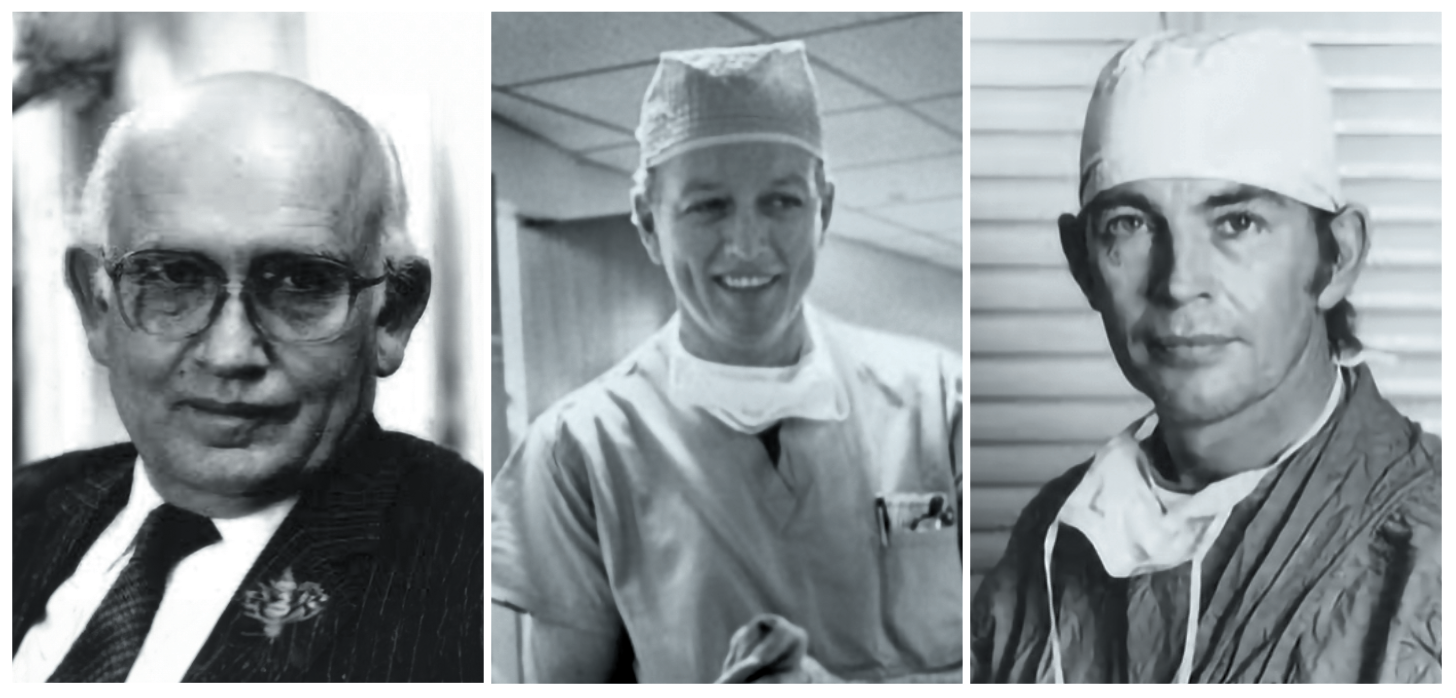Exposure of a dilated conduit in the right hemithorax to the respiratory cycle also may increase aspiration risk. Closure of the mediastinal envelope offers several potential anatomic advantages. In the absence of mediastinal envelope closure, the conduit is suspended from the anastomosis and a few other points of tension. Anastomotic tension, exacerbated by gravity in the upright esophagectomy patient, impedes tissue perfusion and can be mitigated by creating a thinner conduit and subsequent mediastinal envelope closure. The mediastinal pleural envelope closure also maintains the conduit in a linear cephalocaudal position, promoting streamlined emptying through gravity.
Finally, the pleura is a natural protective barrier with blood supply from both the intercostal and pulmonary vasculature; the mediastinal envelope may function similarly to an omentoplasty without diverting gastroepiploic blood flow. We have found that partial closure of the mediastinal envelope (e.g., below the level of the anastomosis) does not reduce postesophagectomy complications as effectively as full closure of the mediastinal envelope.
The primary condition limiting mediastinal envelope closure is excess tension. Occasionally we cannot perform complete mediastinal envelope closure. When this is the case, we prefer to leave the entire mediastinal envelope open as we have found that partial closure can lead to increased anastomotic leaks (in press). Bulky conduits and excess omentum can impede closure, while preoperative radiation occasionally makes the pleura too friable. Although conduit revisions can be more complex with a slender conduit, we find that a slender conduit is less ischemia-prone, possibly because the right gastroepiploic artery’s branches have a shorter distance to travel circumferentially with a reduced volume of tissue to perfuse.
In a multicenter retrospective cohort study of adult patients undergoing minimally invasive esophagectomy (in press), we found that complete closure of the mediastinal envelope led to improved outcomes compared to nonclosure or partial closure. Partial closure is defined as closure only below the level of the ligated azygous, leaving the anastomosis exposed.
The complete mediastinal envelope closure led to a statistically significant decrease in anastomotic leaks (2% vs. 14.7%, p = 0.007); delayed gastric emptying (6.1% vs. 20.6%, p = 0.02); need for pyloric dilation (15.6% vs. 32.4%, p = 0.03); length of stay (2 days vs. 4 days, p <0.001); and 90-day hospital readmission (11.6% vs. 35.3%, p = 0.001).
In particular, patients with no or partial closure of the mediastinal envelope had 3.74 times increased odds of anastomotic leak (p = 0.007). Anastomotic leak is associated with increased length of stay, stricture formation, morbidity, and mortality, but consistently effective interventions are limited. One meta-analysis found only omentoplasty (relative risk [RR]: 22%) and early NG tube removal (within 2 days) or no NG tube (RR: 38%) reduce the risk of anastomotic leak.7 The techniques presented here may offer alternative solutions to reduce common and highly morbid complications for patients after esophagectomy.
In our MIE, we emphasize an efficient operation with deliberate surgical maneuvers. MIE offers several advantages over open esophagectomy, including reduced perioperative blood loss, respiratory infections, and length of stay with improved 1-year quality of life, but MIE also has a longer median operative duration in the literature by more than 30 minutes (MIE: 326 minutes vs. Open: 295 minutes).8 Extended operative and anesthesia time may be uniquely harmful to esophagectomy patients for numerous reasons, including increased blood loss, tenuous conduit perfusion, and protracted single-lung ventilation.
In the laparoscopic phase, in addition to omitting routine jejunostomy tube placement, we do not perform pyloric emptying procedures (i.e., pyloromyotomy, pyloroplasty, or Botox®). Pyloric drainage procedures in MIE have been associated with increased postesophagectomy symptoms and the need for subsequent pyloric dilation.9 Pyloric stenosis is addressed postoperatively as needed, but with the slender conduit and improved emptying due to mediastinal envelope closure, fewer patients require pyloric dilation.
In the thoracoscopic phase, we specifically reduce single-lung ventilation time by using two ENDOLOOP ties to secure the stapler anvil, instead of a purse-string suture with an Endo Stitch™ or laparoscopic needle driver. In another multicenter retrospective cohort study of 368 patients (in press), where approximately one-third of MIE patients had operative durations <4 hours (240 minutes), we found that prolonged operations were associated with increased postoperative complications, specifically respiratory infections and anastomotic leaks. The relationship between operative duration and MIE complications is likely bi-directional. We do not endorse extreme speed, but recommend that surgeons prioritize purposeful, streamlined operative techniques.
Part 2. Multidisciplinary Perioperative Management Emphasizing Early Oral Nutrition
Careful perioperative management of esophagectomy patients is essential, particularly with regard to nutrition. Esophageal cancer has the highest median pre-diagnosis weight loss of all cancers2 and >10% reduction in body weight is common preoperatively.10 After esophagectomy, weight loss and malnutrition continues to be a central issue. With loss of the stomach reservoir and accompanying malabsorption, studies indicate that two-thirds of patients lose more than 10% of their preoperative bodyweight and 20% lose more than 20% by 6-months postesophagectomy.1
Enhanced recovery after surgery (ERAS) pathways are multidisciplinary in nature and, on our team, a dedicated outpatient RD is a key decision-maker.2 Ideally, esophagectomy is performed 6-8 weeks after the last radiotherapy session in our program, but the RD coordinates the timing of surgery with the team based on the patient’s nutritional status as well. Surgery will be delayed if nutritional status is extremely poor.
Beginning 4 weeks before the anticipated operative date, the RD provides the patient with our MIE-focused diet book and meets with him or her weekly, providing tailored education, discussing nutritional goals, and monitoring their current weight. Following each appointment, the surgeon, physician assistant, and RD jointly evaluate the patient’s surgical fitness in a virtual multidisciplinary conference.
















